Polishing your watch is a delicate process that can restore its original shine and remove unsightly scratches. This comprehensive guide covers the best practices, tools, and techniques for both amateur and experienced watch enthusiasts, ensuring your timepiece looks as good as new.
The Basics of Watch Polishing
When it comes to maintaining the aesthetic appeal of a timepiece, watch polishing is an essential aspect to consider. Not only does it enhance the visual appeal of the watch, but it also helps protect the metal from corrosion and wear.
Credit: YouTube Channel - Leonardo's Watchlist
Understanding Watch Finishes
A watch's finish refers to the texture and appearance of its metal components, such as the case, band, and buckle. There are two primary types of finishes: brushed and polished.
Brushed Finishes
Brushed finishes are created by scratching the metal surface in a specific direction using a series of brushes or abrasive materials. This process produces a matte, textured appearance that helps hide minor scratches and fingerprints. Brushed finishes are often used on sports watches, as they provide a more rugged and functional look. For example, the Omega Seamaster Planet Ocean features a brushed stainless steel case that complements its sporty design.
Polished Finishes
Polished finishes involve buffing the metal surface to create a high-shine, reflective appearance. This process requires a series of progressively finer polishing compounds and techniques to achieve a mirror-like finish. Polished finishes are commonly used on dress watches, as they add a touch of elegance and sophistication. The Rolex Datejust, for instance, features a polished stainless steel case that exudes luxury and refinement.
The Importance of Maintaining Original Finish
Maintaining the original finish of a watch is crucial for several reasons:
-
Preserving Value: A watch's original finish is a significant factor in determining its resale value. If the finish is altered or damaged, it can significantly reduce the watch's worth.
-
Preventing Corrosion: A well-maintained finish helps protect the metal from corrosion and wear. This is particularly important for watches exposed to harsh environments, such as saltwater or extreme temperatures.
-
Aesthetics: The original finish of a watch is an integral part of its design. Altering or damaging the finish can compromise the watch's overall appearance and detract from its beauty.
-
Authenticity: Maintaining the original finish helps preserve the watch's authenticity. Tampering with the finish can raise questions about the watch's legitimacy and provenance.
Essential Tools and Materials for Watch Polishing
To achieve a high-quality polish and protect your watch from damage, you'll need the right tools and materials:
-
Sandpaper (1500-2000 grit): This range is ideal for polishing watch cases and bands, providing a smooth finish without being too abrasive. You can find sandpaper with these grit levels at most hardware stores or online retailers like Amazon.
-
Microfiber Cloths: These cloths are gentle on the watch's surface and effective in removing dirt and oils. They are also useful for cleaning the watch after polishing. You can purchase microfiber cloths at auto parts stores or online.
-
Jeweler's Rouge or Polishing Compound: This specialized paste is designed to remove scratches and leave a high-gloss finish. Popular brands include Goddard's, Weiman, and Hagerty, available at jewelry supply stores or online retailers like Rio Grande.
-
Soft Toothbrush or Detailing Brush: These brushes are gentle and won't scratch the watch's surface, making them perfect for reaching small areas and crevices. You can find soft toothbrushes at most pharmacies or online retailers like Walmart.
-
Dremel Tool with Polishing Attachments (Optional): This advanced tool requires some experience with power tools but can provide a highly professional finish. You can find Dremel tools at hardware stores or online retailers like Home Depot.
-
Soapy Water and Baby Wipes: Use soapy water for cleaning the watch during and after the polishing process, and baby wipes to gently wipe away any residue.
Step-by-Step Watch Polishing Process
Polishing a watch requires patience, attention to detail, and the right techniques to achieve a brilliant finish. Here's a comprehensive guide to help you polish your watch like a professional.
Pre-Polishing Checklist
Before you begin polishing your watch, ensure it's prepared for the process:
-
Ensuring Water Resistance: If your watch is water-resistant, apply a thin layer of waterproof grease to the case back and crown gaskets using a small brush to maintain water resistance during polishing.
-
Removing the Bracelet (if applicable): Use a watch band removal tool to release the spring bars holding the bracelet to the watch case. Gently pull the bracelet away from the case, taking care not to scratch the lugs or case.
Removing Scratches
Remove scratches using gentle sanding techniques and progressively smoother grits:
-
Start with coarse grit: Use a 600-grit sandpaper to remove deep scratches. Hold the sandpaper at a 45-degree angle and gently rub it back and forth over the scratched area, applying moderate pressure.
-
Progress to finer grits: Once you've removed the deep scratches, switch to a 1200-grit sandpaper. Repeat the sanding process, gradually increasing the grit to 1500, 2000, and finally, 2500 to smooth out the surface and remove any remaining scratches.
Polishing Techniques
The polishing technique you use depends on the type of finish your watch has.
For Polished Finishes: Using Polishing Compound
-
Apply polishing compound: Using a soft cloth, apply a small amount of polishing compound (such as Goddard's Silver Polish or Cape Cod Metal Polish) to the watch case and bracelet (if applicable).
-
Buff the watch: Using a buffing wheel or a soft cloth, gently buff the watch in a circular motion to remove any remaining scratches and create a high-gloss finish.
-
Inspect and repeat: Inspect the watch under a bright light to identify any remaining scratches. If necessary, repeat the polishing process until the desired finish is achieved.
For Brushed Finishes: Maintaining the Brushed Look
-
Use a gentle cleaning solution: Mix a solution of mild soap and warm water, and use a soft-bristled brush to gently scrub the brushed finish, removing dirt and grime without damaging the finish.
-
Dry and inspect: Use a soft cloth to dry the watch, and inspect the brushed finish under a bright light. If necessary, repeat the cleaning process to maintain the brushed look.
Cleaning and Maintenance
After polishing your watch, clean and maintain it to prevent dirt and grime from accumulating:
-
Soapy Water Bath: Mix mild soap and warm water in a bowl, submerge the watch for about 15 minutes, then rinse with a soft cloth under running water and dry with a soft, lint-free cloth.
-
Drying and Final Wipe Down: Gently wipe down the watch with a microfiber cloth to remove any remaining moisture. Inspect the watch under a bright light to ensure it's clean and dry, then store it in a cool, dry place, away from direct sunlight.
Polishing the Crystal
Polishing the crystal of a watch is a delicate task that requires careful consideration and the right tools.
Safe Methods for Crystal Polishing
For vintage acrylic watch crystals, use a scratch remover like PolyWatch or PlexiRevive. Apply a pea-sized amount to a cotton cloth and rub the crystal in even circles. Stop polishing when the emulsion is fully worked in, indicated by a squeaky noise or a slightly rougher feel. Avoid overpolishing, as this can remove too much material and potentially damage the crystal.
When to Seek Professional Help
If you are unsure about polishing your watch crystal yourself, seek professional help. A watchmaker or jeweler with experience in polishing watch crystals can provide guidance and ensure the process is done correctly. If the scratches are deep or the crystal is made of a different material like sapphire, professional assistance is recommended to avoid causing further damage.
The Risks of Overpolishing
Overpolishing a watch can have significant consequences, particularly for vintage models.
Impact on Value and Integrity of the Watch
Removing too much metal during the polishing process can alter the original finishing and shape of the watch, reducing its value. Overpolished Rolex watches, for example, can lose their crisp lugs and beveled edges, making them less desirable to collectors. Moreover, overpolishing can remove the patina and character of a watch, which are often valued by collectors.
Knowing When to Stop
To avoid overpolishing, know when to stop. This can be determined by the depth of the scratches and the type of material being polished. If the scratches are shallow and only on the surface, polishing can be done carefully to remove them without damaging the underlying material. However, if the scratches are deep or the material is delicate, seek professional help or avoid polishing altogether.
Determining When to Polish
Polishing a watch is essential for maintaining its appearance and longevity, but it's crucial to determine when to polish to avoid unnecessary wear and tear.
Frequency of Polishing
The frequency of polishing largely depends on factors such as the type of watch, usage, and environmental conditions. Generally, a watch should be polished every 6-12 months, depending on how often it is worn. If you wear your watch daily, it may require polishing every 6 months to maintain its shine and prevent scratches. If you only wear your watch occasionally, polishing every 12 months may be sufficient.
Signs Your Watch Needs Attention
Several signs indicate your watch needs polishing:
-
Scratches and Marks: Visible scratches or marks on the case, band, or crystal.
-
Dullness: A dull or lackluster finish due to oxidation, exposure to sunlight, or wear and tear.
-
Tarnish or Discoloration: Tarnish or discoloration on the watch's metal components, such as the case or band, due to exposure to moisture, saltwater, or certain chemicals.
-
Corrosion: Corrosion or rust on any metal parts of your watch, which can weaken the watch's structure and compromise its functionality.
-
Crystal Damage: Scratched, cracked, or foggy watch crystal, affecting readability and overall appearance.
Using the Right Pressure
Applying the right pressure when polishing a watch is crucial. Too little pressure may not remove scratches effectively; too much pressure risks damaging the watch's surface or movement. The ideal pressure varies depending on the type of watch and the material it's made of. Stainless steel watches typically require moderate pressure, while gold or silver watches demand a lighter touch.
To determine the optimal pressure, start with a gentle touch and gradually increase as needed. Use a polishing cloth specifically designed for watches, such as the Goddard's Silver Polish Cloth or the Cape Cod Metal Polishing Cloth, which provide the right amount of friction without scratching the watch's surface.
Protecting the Watch's Movement
Protecting the movement is critical when polishing a watch. The movement is the intricate mechanism that powers the watch and is extremely sensitive to dust, dirt, and other contaminants. Avoid exposing the movement to any cleaning solutions or polishing compounds, as these can damage the delicate components.
To protect the movement, ensure the watch is properly sealed before polishing. Check the watch's crown and any other openings to ensure they're securely closed. If the watch has a removable case back, consider removing it to prevent any cleaning solutions from seeping into the movement. Additionally, use a soft, clean cloth to wipe away any debris or dust that may accumulate on the watch's surface during the polishing process.
Common Missteps and How to Correct Them
Even with the best intentions, mistakes can happen when polishing a watch. Here are some common missteps to avoid and how to correct them:
-
Using the wrong polishing compound: Avoid using household cleaners or abrasive materials, as these can scratch or damage the watch's surface. Instead, opt for a watch-specific polishing compound like the PolyWatch Watch Crystal Polish or the Brasso Watch Polish.
-
Applying too much pressure: If you notice scratches or marks on the watch's surface, reduce the pressure and start again. It's better to err on the side of caution and gradually increase the pressure as needed.
-
Polishing in circular motions: Always polish in straight, back-and-forth motions to avoid creating scratches or swirl marks. This is particularly important when working with stainless steel or gold watches.
-
Not cleaning the polishing cloth: Regularly clean and maintain your polishing cloth to prevent the buildup of dirt and debris. This ensures the cloth remains effective and prevents scratches on the watch's surface.
-
Not inspecting the watch before polishing: Always inspect the watch before polishing to identify any scratches, dents, or other damage. This allows you to address these issues before polishing, ensuring a smoother, more effective process.
Alternatives to DIY Polishing
While some individuals may be skilled and confident in their ability to polish a watch, others may prefer to seek professional assistance.
Professional Watch Servicing
Professional watch servicing is an excellent alternative to DIY polishing for several reasons:
-
Expertise and Experience: Professional watchmakers and polishers possess the necessary expertise and experience to handle delicate timepieces with care. They are trained to identify and address any underlying issues that may be affecting the watch's appearance or functionality.
-
Specialized Equipment: Professional watchmakers have access to a wide range of specialized tools and equipment, including ultrasonic cleaners, polishing machines, and precision lathes.
-
Warranty or Guarantee: Professional watchmakers often provide a warranty or guarantee for their services, providing peace of mind for watch owners. In the event of any issues or problems, the professional watchmaker can be held accountable and is obligated to correct the issue.
The cost of professional watch servicing can vary depending on the type of watch, its condition, and the level of service required. On average, the cost can range from $50 to $500 or more, depending on the complexity of the work involved. A basic cleaning and polishing service for a quartz watch might cost around $50-$100, while a more comprehensive service for a mechanical watch could cost upwards of $200-$500. High-end luxury watches may require more extensive and specialized services, which can cost $1,000 or more.
DIY Kits vs. Professional Services
While DIY polishing kits can be a cost-effective option, they often lack the expertise and specialized equipment that professional watchmakers possess. DIY kits typically include a set of polishing compounds, cloths, and instructions, which may not be sufficient to achieve the desired results. Without proper training and experience, individuals may inadvertently cause damage to their watches, such as scratching or over-polishing.
In contrast, professional watchmakers have the necessary knowledge and skills to identify and address any underlying issues that may affect the polishing process, ensuring your watch is polished to perfection while also addressing any underlying issues that may affect its appearance or functionality.
Conclusion
Polishing your watch at home can be a rewarding experience, breathing new life into your cherished timepiece. By following these detailed steps and precautions, you can maintain your watch's beauty without compromising its value. Remember, when in doubt, consult a professional to ensure your watch remains a timeless treasure.
We hope this comprehensive guide has provided you with the knowledge and confidence to polish your watch like a pro. If you have any questions, experiences, or tips to share, please leave a comment below. Don't forget to share this article with your fellow watch enthusiasts, and let's keep the conversation going!




